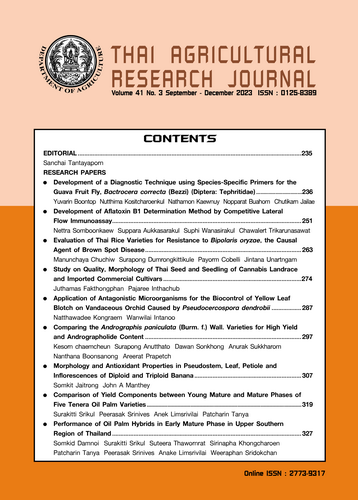Performance of Oil Palm Hybrids in Early Mature Phase in Upper Southern Region of Thailand
DOI:
https://doi.org/10.14456/thaidoa-agres.2023.28Keywords:
Adaptation, Elaeis guineensis Field trial, Yield componentsAbstract
Eight hybrids of commercial oil palm seedlings, 4 from Thai and 4 from oversea sources, were transplanted into the experimental field in AoLuek district, Krabi province,Thailand in 2013. Randomized complete block design (RCBD) was applied with 3 replications. Sixteen palms per plot were random sampling for the agronomic traits data. Growth characteristics were collected every 6 months from 12 to 60 months after transplant (MAT) while the yield data were collected from 31 to 66 MAT, covering a span of 3 years for yield harvesting. The Thai hybrid oil palm tends to have higher production of fresh fruit bunch (FFB) compared to hybrid oil palm from other countries. Hybrids of Deli× Yangambi-T and Deli×Tanzania-T exhibited statistically significant higher vegetative traits such as petiole cross-section, rachis length, and leaflet length when compared to other varieties, The two hybrids also demonstrated significantly higher yields, with maximum FFB valuesof 194.9 and 192.9 kg/palm, respectively in the 3rd year of harvesting.The hybrid with the highest kernel content was Deli × Tanzania-T with kernel to fruit ratio (KTF) and kernel to bunch ratio (KTB) values of 11.94% and 9.40% respectively. On the other hand, Deli× Yangambi-T showed the highest significant oil yield of 8.78 tons/ha/year at the age of 5 years after transplanting. This experiment demonstrates that certain improved hybrid oil palm varieties in Thailand have the potential for better growth, productivity, and superior components compared to imported hybrid varieties from oversea countries.
References
Alvarado, Y. and R.Escobar.2017. Seed production and oil palm breeding. ASD Oil Palm Papers (Costa Rica). 47: 19-26.
Arolu, I.W., M.Y. Rafii, M. Marjuni, M.M. Hanafi, Z. Sulaiman, H.A. Rahim, M.I.Z. Abidin, M.D. Amiruddin, A.K. Din, and R. Nookiah. 2017. Breeding of high yielding and dwar foil palm planting materials using Delidura × Nigerian pisifera population. Euphytica. 213: 1–15.
Barcelos, E., S. D. A. Rios, R. N. Cunha, R. Lopes, S. Y. Motoike, E. Babiychuk, A. Skirycz and S. Kushnir. 2015. Oil palm natural diversity and the potential for yield improvement. Front. Plant Sci. 6: 190.
Beaton, J.D., M. Hasegawa and J.C.W. Keng. 1990. Some Aspects of Plant Nutrition/ Soil Fertility Management to Consider in Maximum Yield Research. pp. 131-152. In: Proceedings Symposium “Maximum Yield Research Satellite Symposium”, 14th International Congress of Soil Science,held at Kyoto, Japan.
Blaak, G., L. D. Sparnaaij and T. Menedez, 1963. Breeding and inheritance in the oil palm (Elaeis guineensis Jacq.) II. Methods of bunch quality analysis. JW Afric. Inst. Oil Palm Res. 4(14): 146-155.
Breure, C.J. 2010. Rate of leaf expansion: A criterion for identifying oil palm (Elaeis guineensis Jacq.) types suitable for planting at high densities. NJAS-Wagen J. Life Sci. 57: 141-147.
Corley, R.H.V. and C.J. Breure. 1988. Measurement in oil palm experiment. UNIPALMOL Company, Malaysia. (Mimeographed). 64p.
Corley, R.H.V. and P.B Tinker. 2016. The Oil Palm.5th ed. John Wiley and Sons, New York. 562 p.
FAO. 2023. Crops and livestock products. Food and Agriculture Organization of United Nation. Available at: https://www.fao.org/faostat/ en/#data/QCL. Accessed: June 9, 2023.
Junaidah, J., M.Y. Rafii, C.W. Chin and G. Saleh. 2011. Performance of Tenera oil palm population derived from crosses between Deli Dura and Pisifera from different sources oninlandsoils. J. Oil Palm Res. 23:1210-1221.
Jing, C.J., I.A. Seman, and L. Zakaria. 2015. Mating compatibility and restriction analysis of ganoderma isolates from oil palm and other palm hosts. Trop. Life Sci. Res. 26(2): 45–57.
OAE. 2023. Harvesting area and yield of oil palm. Office of Agricultural Economics. Available at: https://www.oae.go.th/assets/portals/1/ files/oilpalm%2064.pdf. Accessed: June 6, 2023. (in Thai)
Popet, P., T. Eksomtramage, J. Anothai and T. Khomphet. 2022. Correlation and path analysis in commercial Tenera oil palms collected from southern Thailand. Indian J. Agric. Res. 56(4): 485-488.
R Core Team. 2021. R: A Languageand Environment for Statistical Computing. R Foundation
for Statistical Computing, Vienna, Austria.
Rao, V., A.C. Soh, R. H. V. Corley, C. H. Lee, N. Rajanaidu, Y. P. Tan, C. W. Chin, K. C. Lim, S. T. Tan, T. P. Lee and M. Ngui. 1983. A critical reexamination of the method of bunch quality analysis in oil palm breeding. PORIM Occasional Paper. 9: 1-28.
Rao,V. and K.C. Chang. 2018. MS 157: An evolving story. The planter. Kuala Lumpur. 94 (1109): 491-502.
Tabatabaei, S.A., V. Rafiee and E. Shakeri. 2012. Comparison of morphological, physiological and yield of local and improved cultivars of cotton in Yazd province. Intl. J. Agron. Plant Prod. 3 (5): 164-167.
USDA. 2023. Palm oil 2023 of world production. U.S. Department of Agriculture. Available at: https://ipad.fas.usda.gov/cropexplorer/cropview/commodity View.aspx?cropid= 4243000. Accessed: June 6, 2023.
Wongsri, O., K. Thanarak, S. Srikul, C. Chawana, V. Omzubsin, Y. Riyapan, S. Promchue and S. Kolasuek. 2019. Breeding of oil palm for high yield: hybrid variety Suratthani 7. Thai Agric. Res. J. 37: 78-92. (in Thai)
Downloads
Published
How to Cite
Issue
Section
License
Copyright (c) 2023 Thai Agricultural Research Journal

This work is licensed under a Creative Commons Attribution-NonCommercial-NoDerivatives 4.0 International License.
Thai Agricultural Research Journal



